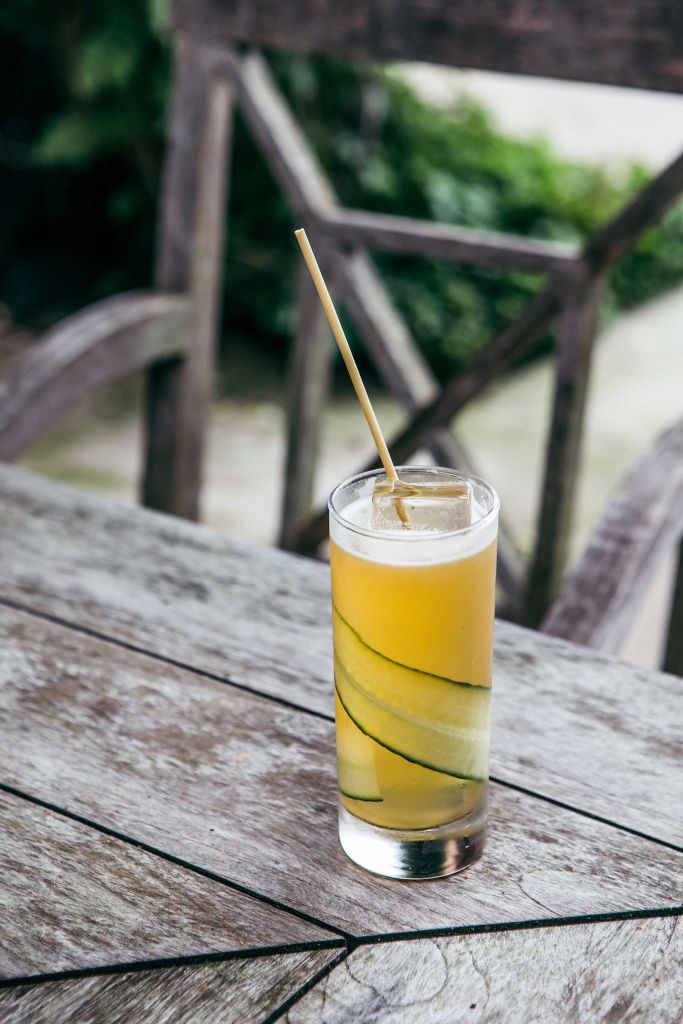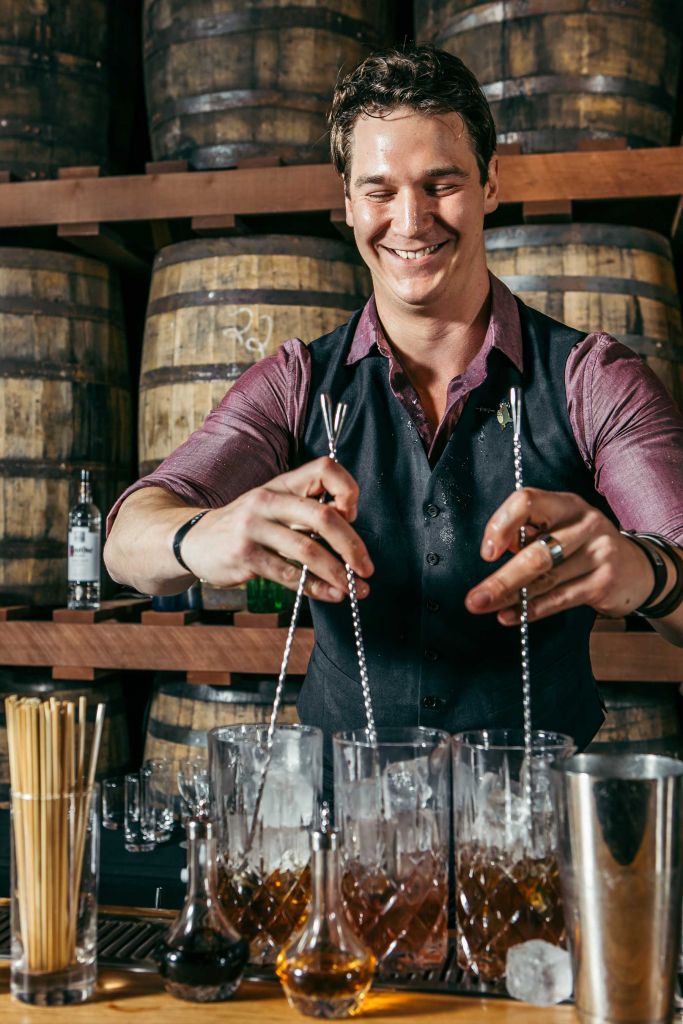Hailing from Erie, Pennsylvania, Adam Fournier has spent the past dozen years crisscrossing Los Angeles and elevating bar scenes while doing so. From neighborhood-defining spots like Santa Monica’s now shuttered Ariel to Downtown’s game changers like Faith + Flower (also now closed) and NoMad, the Pennsylvania native has been an intricate part of the City of Angels’ blossoming cocktail scene. In April, the United States Bartenders’ Guild (USBG) and Diageo named him the 2021 U.S. Bartender of the Year after he won the USBG Presents World Class sponsored by Diageo.
“[Ariel] is where I first entered World Class,” Adam tells me. “I met my current partner while I was at Ariel and, she’s a big veteran of the spirits industry as well, and she was like, ‘you know, you seem like, you feel like you have something to prove, you should look into this program.’ And she convinced me to go out for the first time and I ended up making it to the Western regionals, five years ago, for the first time when the Western regionals were held in Hawaii, which I still to this day claim to be the best location, nothing but the hotel. I competed that year and did really well.”

Five years later Adam is still competing in the annual Diageo World Class. “The reason I’m still doing it this year, five years later, is because the program actually offers really amazing feedback to all the competitors. After you compete, you get all the judges notes and feedback and a general ranking score where you fell in the scoring for different parts of not even just the challenge in general, but parts of the challenge as well.”
This year’s Diageo World Class, due to the COVID-19 pandemic, was the first ever entirely digital version of the competition. While it certainly presented an initial challenge to Diageo, the British drinks giant responded by making the playing field more even than ever. “Every single competitor got a filming kit with a ring light, a Lavalier microphone, instructions on how to properly frame and light and record. So that way everyone’s working with the same equipment and it was just sent off to professionals to edit it all together to make sure it’s like, great, you’re going to perform whether it’s in your house, whether it’s in a bar or whatever you have, you’re all working from the same playing field,” explains Adam. “We all got a beautiful bar kit full of craft house bar tools, you know, Charles Joly’s line.
“So everyone had the exact same access to the same quality of tools like world-class tools. So that way, no one felt like they were behind on the eight ball or things like that. So you can really just focus on the cocktails, the challenge and your presentation”
This year’s Diageo World Class tested the nation’s top 50 bartenders. The regional finals kicked off with the “Underground Agriculture” challenge that tested competitors’ bartending and storytelling skills. The “Batched and Ready To-Go Challenge” had participants create and demonstrate batched cocktails for at-home enjoyment. The Top 10 finalists competed in the “Menu Challenge” where they created a menu of seven cocktails for an assigned bar or restaurant. Lastly, the “Speed Round” had the Top 5 finalists preparing five classic cocktails in under five minutes using spirits from the Diageo Reserve Portfolio.
Over the course of the competition, Adam created 14 cocktails. Unfortunately, I was only able to try two, the Concordia and the Piñacillin (ingredients and instructions at the bottom). “The Concordia is from the back to our roots challenge,” explains Adam. There, competitors had to create a drink that ties into their roots, whether that’s their home, where they live now, or whatever else that means to them. The Piñacillin, meanwhile, was part of the speed round.

Both cocktails carry a story that’s unique to Adam. “That’s a big part of what I do when it comes to cocktails and when it comes to making things,” he shares. “I want to have a story that connects, not something that you need to know the moment you get to drink, but by the third time you come around and sit down at my bar and you’ve had it and you’re like, “This drink is really good. Why is it so good? Or why is it different than this?’”
“The Concordia is the story of my journey from Pennsylvania to California,” he explains. “I took both of these parts of my life, which are my roots, and told a story with them using something that they both have in common, which is grapes. I know no one ever thinks that about Pennsylvania, but I grew up in Welch’s country, my entire neighborhood and where I grew up is Concord grape vines. I used to walk through there and my birthday’s in September, right when they’re getting ripe. So every year, I would just walk through and grab a bunch of those. So I took that idea of the Concord grapes with California’s great and noble vines and made essentially a grape syrup saba or reduction out of California table grapes to pick out that Concord grape juice to create something that was nice and bright and carried all that like tannin and sour.
“That was a starting idea, but then I wanted to tie some more into Pennsylvania. So there is essentially a grape soda float from Pennsylvania called the purple cow. So great. I want to kind of recreate that idea by now from California. Dairy is a no-no. Okay, so almond milk, we’re going to start playing around that to give it that texture and that flavor. And then, grapes, one of my favorite things is to be an educator, grapes want to be wine so badly that it took us until the late 1800s to figure out how to stop them from turning into wine. And that’s how Welch’s got started. It was a teetotaling thing, so I wanted to have something as low ABV, so I pulled in the Sherry for that. At that point Tanqueray 10 was the only spirit that made any sense to me because we have all those big, bright tannins, so the citrus heart from Tanqueray 10, all that big, bright, fresh grapefruit, and orange pulls through and ties in with those darker, more traditional gin notes. All of a sudden you have this drink that combines as a through-line, as a through-line from the spirit to the story, but both of them can’t exist without each other.”
The Piñacillin was created when Adam was challenged to use Johnnie Walker to make a cocktail for an outdoor music festival, two concepts that can seem far apart at first glance. “For the Piñacillin, I wanted to have something entirely representative of Johnnie Walker Black Label,” explains Adam. “This is an icon of whiskey. Like, you know what I mean? This is something that you look at as a benchmark, not only the style, but of quality across the board. So if you’re going to represent this at a music festival, how do you represent this in a way that does justice to its legacy. Okay, well, you have to give people a way in, the Penicillin is arguably, at this point, as famous as Johnny Walker Black, great, we’re going to pull those two together. So how do we take something that’s traditional and modern and make it so it works in even more modern contexts. So it went very, very traditional, but why not lengthen that out and give it a little bit of bright tropical notes. Johnny Walker Black, one of the things people don’t necessarily pick up on right away, is that there is this beautiful tropical line through it. It goes really well with coconut water, it goes really well with pineapple. So pulling that in and giving this drink that now is very much Scotch, but it’s absolutely only a single serve, nice in length. And it’s something that you can drink while you’re outside in the afternoon, or while the headliner comes on, as the night goes on. The story and the brands feed into each other.”
Concordia
Ingredients:
- 1 oz. Tanqueray 10
- 1 oz. Fino Sherry
- 1 oz. Almond Milk
- 1 oz. Concord Grape Juice
- 0.75 oz. Saba
- 0.5 oz. Fresh Lemon Juice
Combine all ingredients in a shaker tin. Whip with three ice cubes. Double strain over crushed ice in a 13.25 oz. Poco style glass. Garnish with a mint plouche and straw. Cap with more crushed ice and finish with three carbonated grapes.
Ideal Serve: 13.25 oz. Acopa Poco glass
Piñacillin
Ingredients:
- 1.5 oz. Johnnie Walker Black Label
- 0.25 oz. Honey Syrup (2:1)
- 0.25 oz. Ginger Syrup (1:1)
- 0.5 oz. Fresh Lemon
- 0.5 oz. Fresh Pineapple Juice
Combine all ingredients into a cocktail shaker. Shake with ice until fully diluted and aerated. Double strain over fresh ice. Using a spray bottle, mist the top of the drink with Lagavulin 16. Garnish with two trimmed pineapple fronds.
Ideal Serve: Rocks glass
For more information on the annual World Class competition and the Diageo Bar Academy, head over to the official website.



